Charts presented in this report are courtesy Stockcharts.com unless indicated.
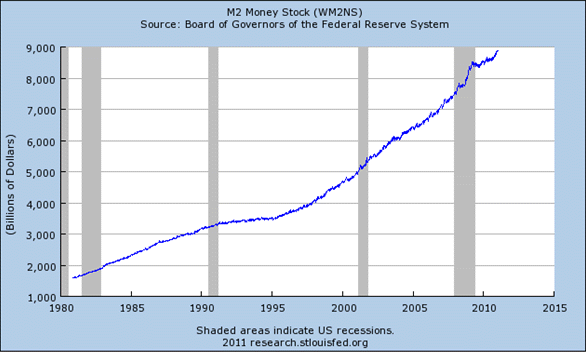
This chart courtesy Federal Reserve Bank of St. Louis shows the increase in M2 money supply is speeding up again after a somewhat slower rise during the past year. This represents monetary inflation, which precedes price inflation, which in turn provides energy for gold, silver and many other commodities.
"The central economic problem plaguing this country since 1913, has been the presence of the federal Reserve System. Without the FED's debt-currency scheme having effectively supplanted the constitutional monetary system based upon silver and gold, would have been impossible - not simply improbable, or difficult, but impossible - for politicians in the public sector and speculators in the private sector to have amassed the staggering level of un-payable, unconstitutional, and unconscionable debt that now bear down upon this country." Dr. Edwin Viera, Jr. (from: 'Going to the roots of the Problem').
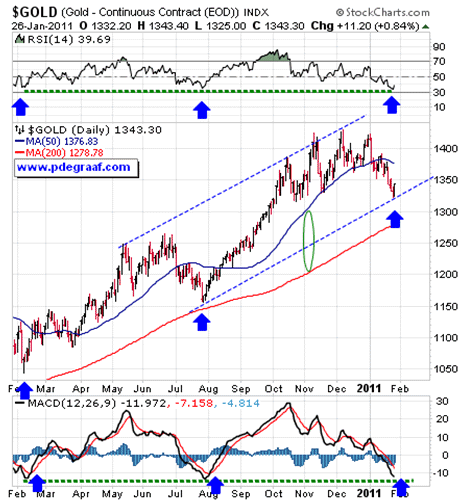
Featured is the daily gold price chart. The blue arrows point to buying opportunities. The 50DMA is in positive alignment to the 200DMA (green oval), and the latter is rising. This is bullish action. Price is turning up while the supporting indicators are at support levels (green lines). Gold and silver usually suffer a seasonal decline in January or February, and Wednesday most likely mared the end of that decline. The Gold Direction Indicator rose up from 28% on Tuesday to 71% on Wednesday.
CBO's Revised Budget Sees 2011 Deficit Rising By $500 Billion To $1.5 Trillion; $4 Trillion In Deficit Through 2013 Guarantees QE3+
This news item by itself should make you want to buy silver and gold. The strongest foundation beneath the bull market in precious metals is budget deficits. This fact was emphasized in the 1970s by James Blanchard III at his New Orleans hard money conferences.
Budget deficits are never closed by cutting government services ( token cuts are merely symbolic). They are covered by borrowed money and by monetary inflation.
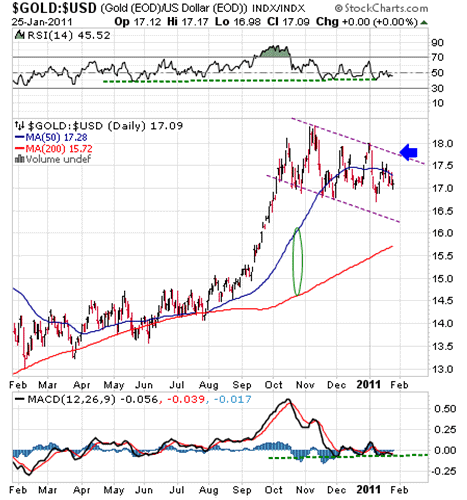
Featured is the index that compares gold to the US dollar. Price is carving out a bullish flag formation. The current pullback appears quite normal within the ongoing bull market. A breakout at the blue arrow will be very bullish for gold. The supporting indicators are at support levels (green lines).
During the 1970 - 1980 inflationary period the 'asset protectors' were: silver, gold, oil, diamonds and farmland. Stocks and bonds did not keep pace.
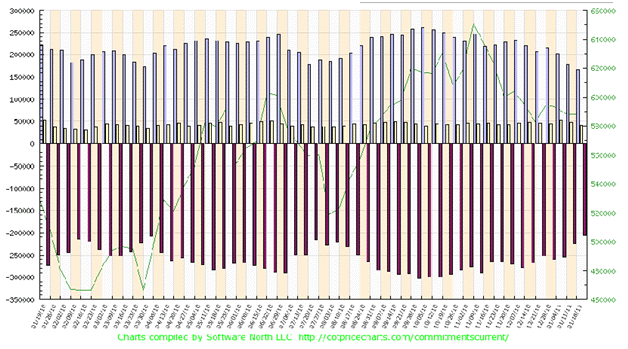
Featured is the COT gold report courtesy Cotpricecharts.com. The 'net short position' of commercial traders dropped 18,000 contracts, to 207,000 as of Tuesday Jan. 18th. This is the lowest number since August 21 2008! Gold on that date was $952 and over the next 5 months it rose 19% to $1138. If a new COT report were to be released today, it would actually turn out to be lower still, because gold has dropped in price since the release of the latest report. As it is, the 'net short' position (purple bar), and the 'net long' position of large speculators (grey bar), are the most bullish of any week in this chart! The next COT report is due out this Friday Jan 28th and is expected to be even more bullish than this one!
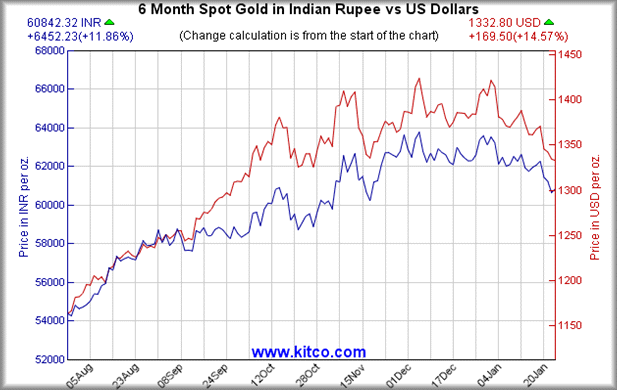
This chart courtesy Kitco.com shows the gold price to be a bargain for buyers in India. They are able to buy gold at the same price as back in November. Indians love bargains!
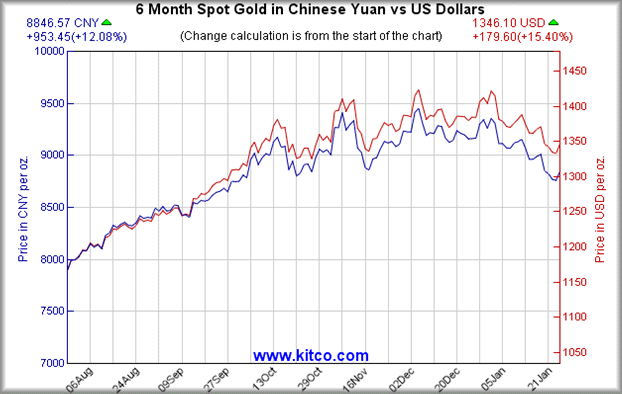
This chart courtesy Kitco.com shows the gold price in Chinese Yuan. The buyer in China is able to buy gold at the same price as back in October. The Chinese also love a bargain, and this comes just in time for the New Year celebrations that begin on Feb 3rd 2011 AD. The Chinese are well aware of price inflation and the need to protect themselves from this inflation by buying gold.
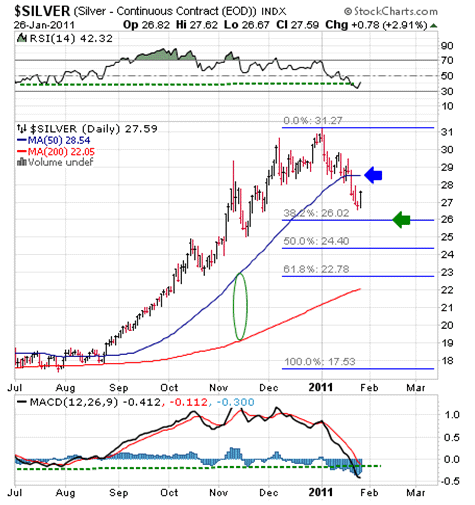
Featured is the daily silver chart. Price became overbought at the end of December and the Fibonacci target for the pullback is at 26.02. Price turned up on Wednesday while the supporting indicators are oversold (green lines). A close above the blue arrow turns the trend bullish again. The 50 DMA is in positive alignment to the 200 DMA (green oval), and both are rising.
Fundamentals for silver are very bullish. In the 1950s an estimated 10 billion ounces were stockpiled around the world. In 1965 the US government owned a strategic stockpile of over 6 billion ounces. By 1980 the worldwide supply of silver was down to an estimated 3.5 billion ounces. Today estimates range between 500 million and at most 1 billion ounces. Silver is being used up faster than mines can produce silver, and the 'easy to find' silver from Peru and Mexico is 'long gone'. Mines are expensive to build, and rising fuel prices cut deeply into miners profits. Meanwhile the industrial uses for silver continue to rise. Silver is used in cell phones, computers, TVs, refrigerators, electrical applications, medicine, weapons, satellites, water filters just to name some of the applications. Whereas gold gets recycled, the amount of silver used in industry is primarily in small amounts and ends up in landfill. The ratio between gold and silver (currently at 48), could one day end up being even!
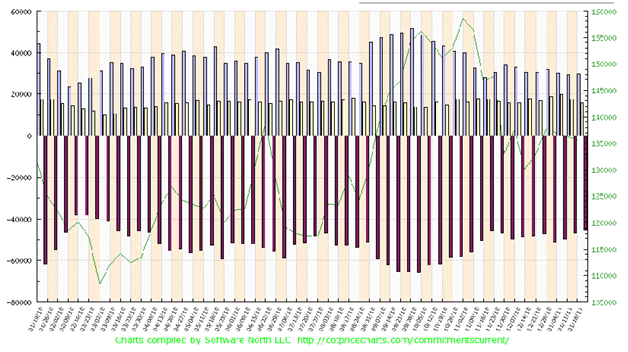
This chart courtesy Cotpricecharts.com shows the 'net short' position of commercial silver traders to be the lowest since March 2010. Back then silver was 17.37 and it rose during the following two months to 19.34, an increase of 11%, (66% annualized). The total 'net short' position as of Tuesday Jan. 18th is 45,000, compared to 47,000 the week before, and this does not reflect the action from Thursday Jan 29th, when silver was knocked down to the tune of -1.20. Once that action is added to the data, (as it will be in the report that is issued this Friday), the 'net short' position is very likely to be the most bullish in several years!
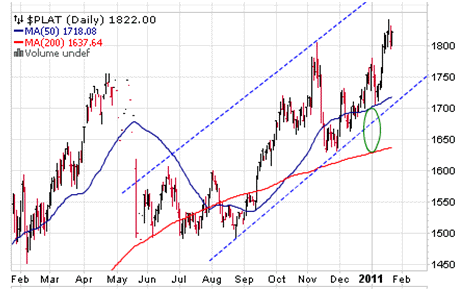
Featured is the daily Platinum chart. Platinum is telling investors in gold and silver: "don't worry - be happy - follow me."
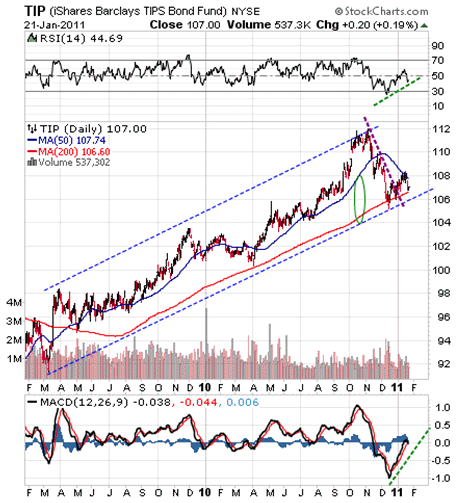
Featured is the TIP bond fund that consists of bonds that are indexed to inflation. The people who buy these bonds are trying to protect themselves from price inflation. An uptrend in the fund indicates that those who believe price inflation is occurring, are in the majority.
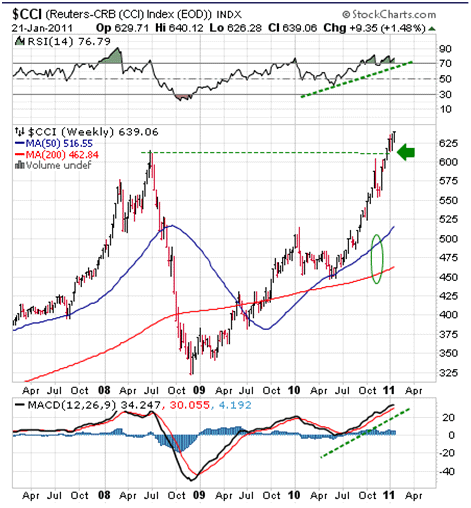
Featured is the CCI Commodity Index, weekly chart. Price broke out to a new all-time high this past week. The expectation is that the breakout at the green arrow will be tested, and if the test is successful, commodities will have blue sky above. The RSI and MACD are positive and the 50 DMA is in positive alignment to the 200 DMA while both are rising.
A few bullish factors to be considered:
- Newly mined gold is not keep pace with newly printed money.
- As oil prices rise, mining costs increase - especially the cost of building a mine from scratch.
- Food prices are rising in a number of countries. This is one of the results of monetary inflation, as it produces price inflation.
- Chinese New Year begins February 3rd and runs for 15 days. It is a season of gift giving, and this year the number of millionaires has increased again over last year. Chinese people love gold and whereas the government prohibited gold ownership for many years, it now openly encourages its citizens to own gold.
- Central Banks are continuing to buy gold, instead of selling gold into the marketplace - as they did for years.
- Since the last gold rush in the late 1970s, the number of people on the planet has increased by several billion. 40% of these new citizens live in China and Asia.
- "Chinese gold and silver demand has been phenomenal ahead of the New Year holiday," said Adrian Ash, head of research at BullionVault.com, a leading online service for gold bullion trading and ownership, citing comments from dealers among others. Shipments have been "heavy" and they began very early, in mid-December, he said.
- Western governments continue to run deficits. These deficits are covered with borrowed money and with printing press money.
- The US government is destroying the value of its currency and the nations against which the US dollar is compared in the US dollar index, are destroying their currencies in lock-step, in order to remain competitive in the market place. The only way you can measure this ongoing destruction is in the price of gold, silver and other scarce resources.
- Quantitative easing is here to stay, for to stop now guarantees the various economies would dive off a cliff.
- The multi-trillion dollar time-bomb of OTC derivative instruments is still bogging down progress in the world's major banks. Central banks are printing money to shovel into these banks to keep the bottom line from showing too much red ink. Meanwhile some of the banks are using part of this money to reward their employees. This widens the gap between rich and poor and sets the stage for civil unrest.
- When government spending rises while revenues are dropping, the resulting gap begins to widen exponentially instead of arithmetically.
- A pull-quote from the latest article by economist Daniel R. Amerman: "The truly big picture for both the United States and most other major developed nations is that population growth has been shrinking, long term promises to current and future retirees have been extravagant, and for the most fundamental of demographic and economic reasons, the nations simply can't afford to pay for those promises. On a global basis, governments are left with a choice between breaking promises by openly reneging on their legal commitments on a massive scale, possibly having to actually declare bankruptcy in many cases (effectively) - or they can follow the time-honored route that almost every nation which has found itself in the situation and has had the ability do so has done: they can pay their promises in form, but not in substance. They can inflate away the value of their national currency, and pay everything in full, but that currency will only be worth a fraction of what it is right now".
- Since 2005, the January through March period has seen China's private household gold demand average a rise of 22% from the previous nine months, according to a BullionVault analysis, based on GFMS data courtesy of the World Gold Council.
- "Long term, that has meant Chinese households have put an ever-greater proportion of their fast-growing annual savings into gold," said Ash, with that portion growing from 0.8% of retained income in 2001 to a forecast of more than 1.7% in 2010.
- Until a major fiat currency becomes trustworthy, there is no alternative store of value that compares with gold and silver.
- Premiums for gold bars in China jumped to their highest level in two years.
- Precious metals dealers in China report very strong demand for gold from China. Refiners cannot meet the demand.
- The World Gold Council preliminary report shows gold sales into India will be the highest in its history.
- Eric Sprott, chief investment officer of Sprott Asset Management, after having difficulty locating enough bullion for their new silver fund was quoted : "Frankly, we are concerned about the illiquidity in the physical silver market. We believe the delays involved in the delivery of physical silver to the Trust highlight the disconnect that exists between the paper and physical markets for silver."
- Sales of silver Eagles set a new record in January, by the 19th of the month. Already, 4.6 million coins have been sold, an all-time monthly high since the coin's release in 1986.
- Gold and gold mining stocks represented 26% of all global assets in 1981 (high inflation), and 20% in 1932 (high deflation). Today, gold and gold mining shares represent about 1% of global assets.
- John Embry of Sprott Investments, in a recent article for Investors Digest expressed doubts that all of the gold in the gold ETFs is physical, (suspecting that some of it consists of COMEX contracts).
- Mr. Embry further observes that gold is re-establishing itself in its historical role as money.
********
DISCLAIMER: Please do your own due diligence. Investing involves taking risks. I am NOT responsible for your trading decisions.
Happy trading!
Peter Degraaf is an online stock trader with over 50 years of investing experience. He publishes a weekly as well as a daily report for his many subscribers. For a sample copy please send him an E-mail at itiswell@cogeco.net or visit his website www.pdegraaf.com







